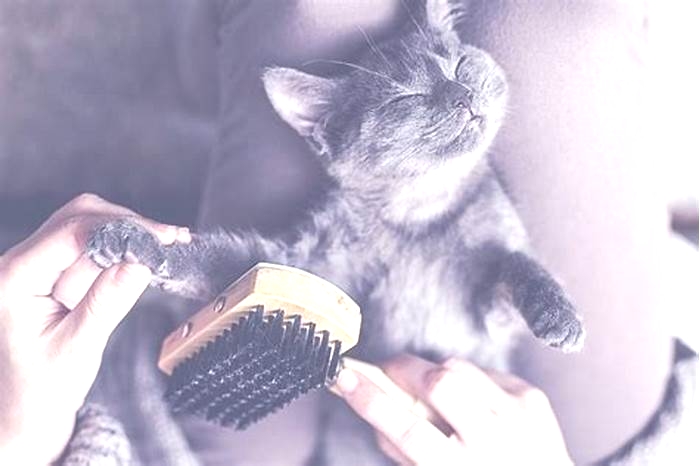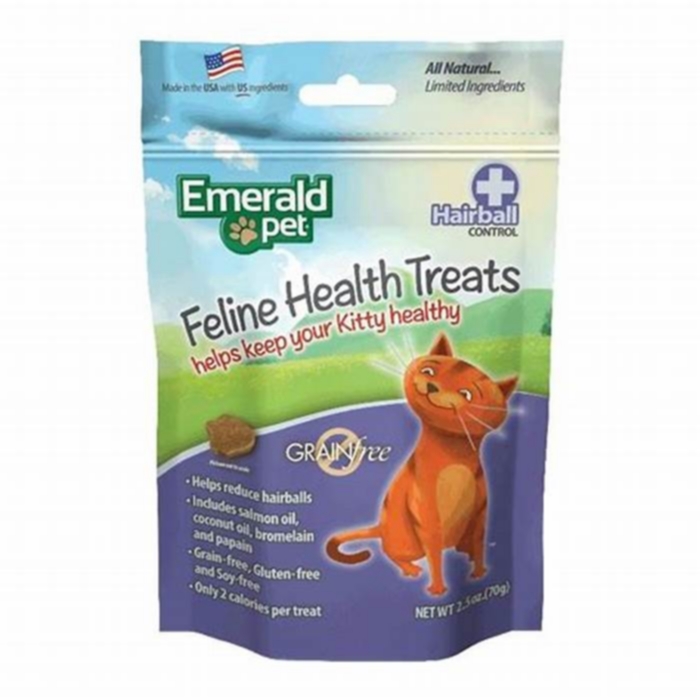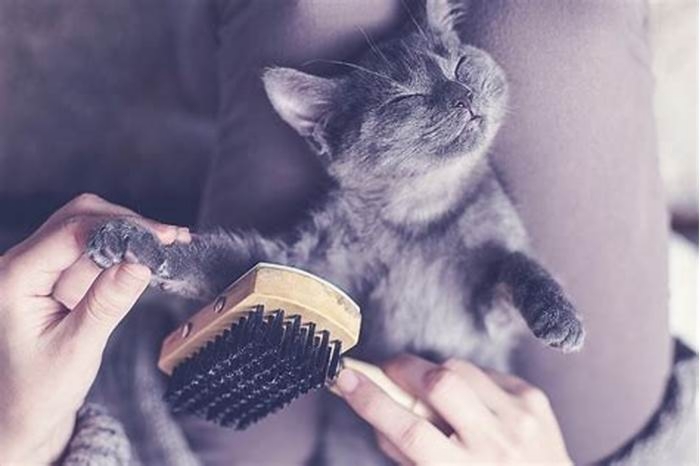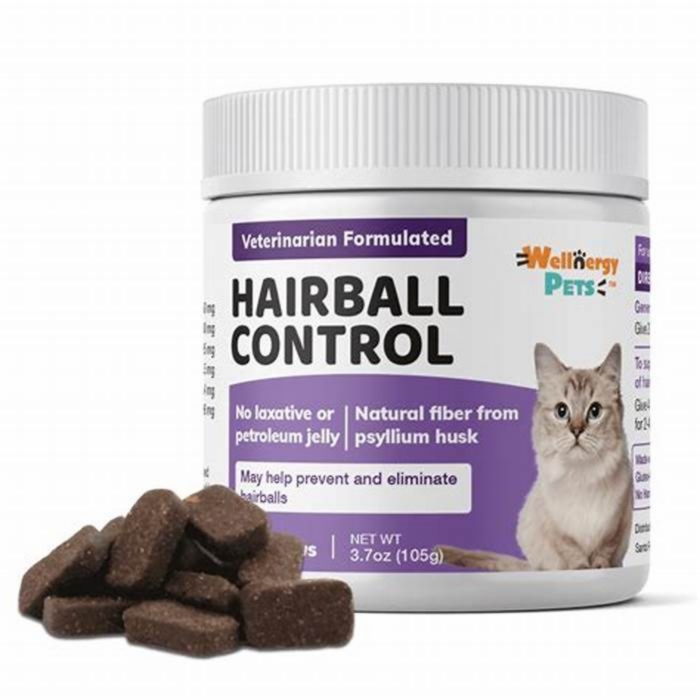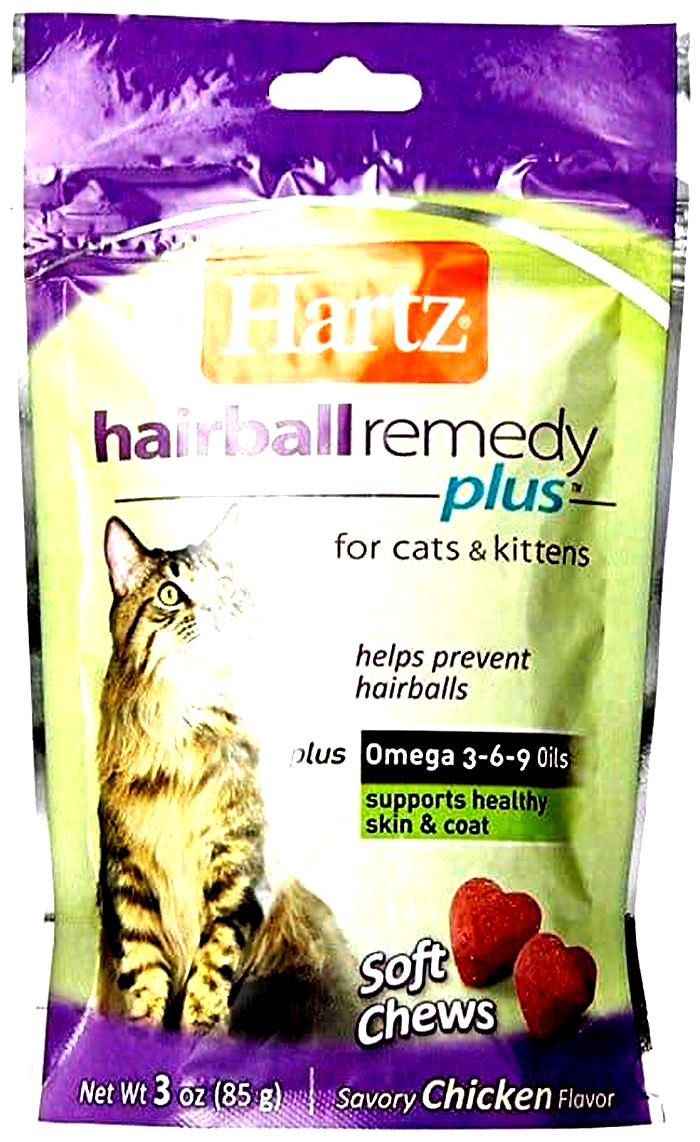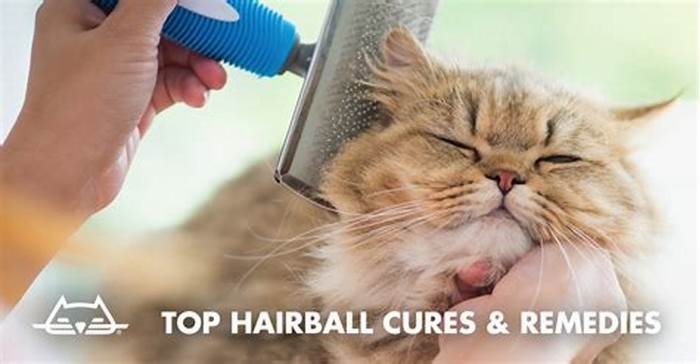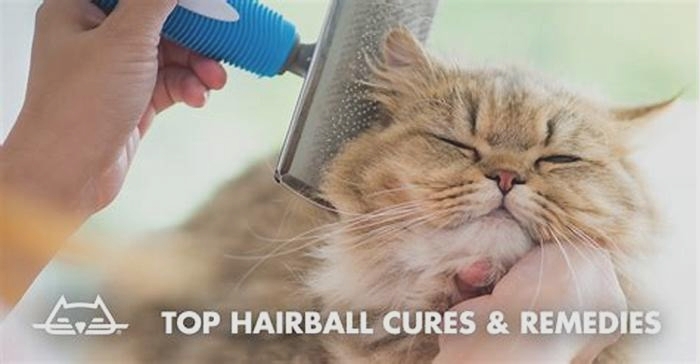Cat Health Essentials Understanding Hairball Control Treatments
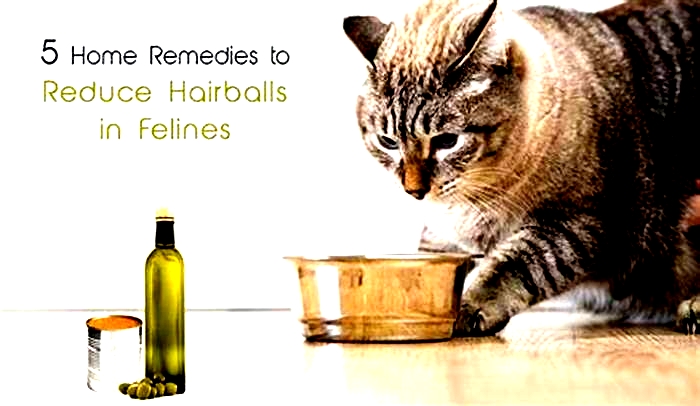
Free of Fur Balls
What exactly are fur balls?
Cats are very clean creatures and your kitten will spend approximately five hours a day grooming themselves. In doing so, they'll pick up any loose hairs from their coat. These are difficult to spit out and will probably be swallowed. Most of the time, this will cause no problems whatsoever and the hairs will just pass through the digestive tract. Sometimes, however, the hairs can remain in the stomach and form a fur ball.
How does the fur ball get out?
Usually, once a fur ball has reached a certain size, the cat vomits it up (look out for sausage like balls of hair), although some will pass hair in their stools. Either way, it rarely causes much distress. Every now and again, a fur ball can be difficult to get rid of and the affected kitten may have repeated bouts of gagging or vomiting. If you are at all concerned, don't hesitate to call your vet.
In some very rare cases a cat may be unable to pass the fur ball naturally and surgery may be required. Thankfully, this is very unusual.

How can you help to prevent fur balls?
One of the best ways to help prevent fur balls is to groom your kitten regularly. Get into the habit of doing this when they are very young, so they get used to it.
Preventing a bad hair day
The type of grooming brush you use can be important and your vet can offer you advice on which one is best for your kitten. Many people with short-haired kittens favour a rubber brush. They're soft enough not to cause any discomfort but great at removing loose hair. If you have a long-haired kitten, you'll need to be even more diligent with grooming. A large-toothed, metal comb is probably a good choice. You'll need to step up the regularity of your brushing during Spring and Summer when your kitten will moult more heavily. This needn't be a chore, though. It can be a good way for you and your kitten to bond. A cuddle or a game is a nice way to round off a brushing session.
Can diet have a role in preventing fur balls?
There is some evidence that a high fibre, dry food such as Hill's Science Plan Adult Hairball Control can help reduce the formation of fur balls in the gut. Ask your vet for advice.
Remember - fur balls may not be nice but they're rarely anything to worry about
Seeing your kitten struggle with a fur ball can be upsetting, but it's important to remember that most cats have problems with them from time to time and there's hardly ever any reason for real concern.
Owning a Persian Cat: A Complete Guide
Have you ever been thinking about owning a Persian cat?
Persian cats are among the most iconic and beloved cat breeds in the world.
Known for their striking appearance and regal demeanor, these cats have captured the hearts of cat enthusiasts for centuries.
The history of Persian cats can be traced back to ancient Persia, present-day Iran, where they were highly regarded for their beauty and elegance.
They were treasured pets among the nobility and were often depicted in works of art, showcasing their luxurious long coats and expressive eyes.
One of the most striking features of Persian cats is their long and flowing coat, which comes in a variety of colors and patterns.
Their fur requires regular grooming to keep it in optimal condition.
Beyond their physical beauty, Persian cats are known for their gentle and calm nature.
They are often described as quiet and reserved, preferring a peaceful environment.
This makes them ideal companions for individuals or families who value a serene and tranquil home.
Throughout this article, we will delve into the various aspects of owning a Persian cat.
We will talk about selecting a Persian cat that suits your lifestyle to understanding their nutritional needs, grooming requirements, and healthcare considerations.
We will also explore their behavior patterns, providing insights into their communication cues and how to create a nurturing environment that promotes their well-being.
Get ready to embark on an enlightening journey into the world of Persian cats.
By the end of this guide, you will have a comprehensive understanding of these majestic felines and all the tools you need to provide them with a happy, healthy, and fulfilling life.
1. Choosing the Right Persian Cat
When it comes to owning a Persian cat, there are several factors to consider.
Each Persian cat has her own unique personality, and finding the right match for your lifestyle and preferences is crucial for a harmonious and fulfilling relationship.
Here is how you can select the perfect Persian cat for you and your family.
Breeder or Rescue:
One of the first decisions youll need to make is whether you want to get a Persian cat from a breeder or adopt one from a rescue organization.
Both options have their advantages.
If you opt for a breeder, ensure they have a good reputation, prioritize the health and well-being of their cats, and provide proper socialization for their kittens.
Rescue organizations can be a great choice if youre looking to provide a loving home for a cat in need.
Kitten or Adult Cat:
Consider whether you want to bring home a playful and energetic kitten or if you prefer the calmer demeanor of an adult Persian cat.
Kittens require more time and attention for training and socialization, while adult cats may already have established personalities and behaviors.
Gender:
Decide if you have a preference for a male or female Persian cat.
Keep in mind that personality traits can vary between genders, but individual personalities matter more than gender stereotypes.
Spend time interacting with both male and female cats to see which one you connect with the most.
You May Like: The Difference Between Male and Female Persian Cats
Coat Type and Color:
Persian cats come in a variety of coat types and colors, including solid colors, tabby patterns, and colorpoint variations.
Consider the grooming commitment required for different coat lengths and the colors that appeal to you.
Temperament:
Spend time observing the cats youre interested in to gauge their temperament.
Look for a Persian cat that matches your lifestyle and energy level.
Some may be more outgoing and playful, while others may be more laid-back and reserved.
Health:
Ensure that the Persian cat you choose is healthy and free from any genetic disorders or health issues commonly seen in the breed.
Request health records and inquire about the breeders health guarantee or the rescue organizations medical evaluations.
Compatibility:
If you have other pets or children at home, consider how the Persian cat will fit into your existing family dynamic.
Introduce the cat to your family members or existing pets before making a final decision.
Remember, bringing a Persian cat into your life is a long-term commitment.
Take your time, do thorough research, and dont hesitate to ask questions to breeders or rescue organizations.
The right Persian cat will enrich your life and bring joy and companionship for many years to come.
2.Bringing Your Persian Cat Home
Bringing a Persian cat home is an exciting and joyful experience.
However, its essential to prepare your home and create a welcoming environment before your new furry friend arrives.
Here are the necessary steps to ensure a smooth transition for your Persian cat.
Preparing a Safe Space:
Designate a quiet and comfortable area in your home where your Persian cat can retreat to when feeling overwhelmed or tired.
This space should include a cozy bed, litter box, food, and water bowls, and some interactive toys.
Gradually introduce your cat to the rest of your home once they feel comfortable in their safe space.
Cat-Proofing Your Home:
Persian cats can be curious explorers, so its crucial to ensure your home is safe and free from any hazards.
Secure loose cords, toxic plants, and household chemicals.
Block access to small spaces where your cat can get stuck or injured.
Consider installing window screens to prevent accidental escapes.
Introducing Family Members and Pets:
If you have family members or other pets at home, introduce them to your Persian cat gradually.
Allow them to interact in a controlled and supervised manner.
Offer positive reinforcement and treats to promote a positive association.
Feeding and Watering Stations:
Set up designated areas for feeding and watering your Persian cat.
Select cat food of a superior quality that fulfills their dietary requirements.
Provide fresh water at all times and ensure the bowls are clean.
Remember to monitor their food intake and adjust portions as necessary to maintain a healthy weight.
Litter Box Placement:
Position the litter box in a tranquil and easily reachable spot.
Persian cats value their privacy, thus opt for a litter box with a cover or consider providing a separate cover for the litter box.
Ensure cleanliness by scooping the litter box on a daily basis and replacing the litter at regular intervals.
Establishing a Routine:
Persian cats thrive on routine, so establish a consistent daily schedule for feeding, playtime, grooming, and sleep.
This helps them feel secure and reduces stress.
Gentle Introduction and Bonding:
Allow your Persian cat to explore their new surroundings at their own pace.
Spend quality time with them, engaging in gentle play and providing affection.
Use positive reinforcement techniques such as treats and praises to strengthen the bond between you and your cat.
Initial Veterinary Visit:
Schedule an initial veterinary visit to ensure your Persian cat is in good health.
The veterinarian will perform a comprehensive examination, update vaccinations if necessary, and discuss preventive care measures.
By following these steps, you can ensure a smooth and successful transition for your Persian cat into her new home.
Remember to be patient, as it may take some time for your cat to adjust fully.
3.Understanding Your Persian Cats Needs
To provide the best care for your Persian cat, its crucial to understand her unique needs and characteristics.
Persian cats have specific requirements when it comes to grooming, nutrition, exercise, and socialization.
Here are the aspects to ensure the well-being and happiness of your beloved feline companion.
Grooming and Coat Care:
Persian cats are famous for their long, luxurious coats, which require regular grooming to prevent matting and maintain their beauty.
Set aside dedicated time each day for grooming sessions.
Use a wide-toothed comb or a specialized cat brush to gently remove tangles and keep their coat in top condition.
Pay particular attention to sensitive areas like the face and tail.
Eye and Tear Stain Care:
Persian cats are prone to tear stains due to their facial structure.
Keep their eye area clean by using a damp cloth or specialized pet wipes.
Regularly check for signs of eye irritation or infection, such as redness or discharge.
In case you detect any abnormalities, it is advisable to seek guidance from your veterinarian.
Nutrition and Diet:
Feed your Persian cat a balanced and high-quality cat food that meets her specific nutritional needs.
Consult your veterinarian for recommendations based on your cats age, activity level, and overall health.
Provide fresh water at all times and avoid feeding them human food, as certain ingredients can be toxic to cats.
Exercise and Play:
While Persian cats are generally known for their relaxed nature, its essential to provide them with opportunities for exercise and mental stimulation.
Engage in interactive play sessions using toys that encourage movement and exploration.
However, be mindful not to overexert them, as Persian cats may have a tendency to be less active compared to other breeds.
Socialization and Bonding:
Persian cats thrive on love and attention from their human companions.
Spend quality time with your cat, engaging in gentle play, petting, and grooming.
Provide them with a safe and secure environment where they can feel comfortable and loved.
Introduce them to new experiences and people gradually, ensuring positive and rewarding interactions.
Healthcare and Regular Check-ups:
Regular veterinary check-ups are vital for maintaining your Persian cats health.
Schedule routine visits for vaccinations, parasite prevention, and overall wellness examinations.
Stay alert to any signs of illness or discomfort, such as changes in appetite, behavior, or litter box habits.
Consult your veterinarian promptly if any concerns arise.
Stress Management:
Persian cats can be sensitive to changes in their environment or routine.
Minimize stress by providing a calm and stable home environment.
Consider using pheromone diffusers or sprays specifically designed for cats to create a soothing atmosphere.
By understanding and fulfilling these specific needs, you can ensure that your Persian cat leads a healthy, happy, and contented life.
4.Feeding and Nutrition for Persian Cats
Proper nutrition is essential for the overall health and well-being of your Persian cat.
Here are the specific dietary needs of Persian cats and the guidelines for feeding them a balanced and nutritious diet.
Choosing the Right Cat Food:
Opt for high-quality cat food that is specifically formulated for Persian cats.
Look for products that contain a balance of essential nutrients, including protein, fats, carbohydrates, vitamins, and minerals.
Read the ingredient list and avoid cat foods that contain artificial additives, fillers, or excessive amounts of grains.
Understanding Protein Requirements:
Persian cats require a diet that is rich in animal-based proteins.
Protein plays a vital role in their muscle development and overall health.
Look for cat food that lists meat, poultry, or fish as the primary ingredient.
Managing Fat Intake:
Persian cats are prone to weight gain, so its important to monitor their fat intake.
Choose cat food with moderate fat content to maintain healthy body weight.
Consult with your veterinarian to determine the ideal feeding portions for your cats age, weight, and activity level.
Avoiding Hairball Formation:
Due to their long coats, Persian cats are more susceptible to hairballs.
Look for cat food formulas that include ingredients such as fiber or specialized additives to aid in hairball control.
Additionally, regular grooming can help reduce the amount of hair that your cat ingests during self-grooming.
Meal Frequency and Portion Control:
Persian cats typically do well with a feeding schedule that includes several small meals throughout the day.
This contributes to the prevention of overeating and enhances digestion.
Follow the recommended portion sizes provided by the cat food manufacturer and adjust as necessary based on your cats individual needs and activity level.
Providing Fresh Water:
Always ensure that your Persian cat has access to fresh and clean water.
Change the water regularly and wash the water bowl to prevent bacterial growth.
Some cats prefer drinking from running water, so consider using a cat water fountain to encourage hydration.
Special Dietary Considerations:
Persian cats may have specific dietary requirements or sensitivities.
If your cat has any health concerns or food allergies, consult with your veterinarian for personalized dietary recommendations.
They may suggest a specialized diet or recommend supplements to support your cats health.
Remember, a well-balanced diet is just one aspect of caring for your Persian cat.
Regular veterinary check-ups, exercise, and grooming are equally important for their overall health and happiness.
You May Also Like: Tortoiseshell Persian Cats: A Beautiful and Unique Feline Breed
5.Grooming Your Persian Cat
Grooming is an essential part of caring for your Persian cat.
Their long and luxurious coat requires regular attention to keep it healthy, mat-free, and beautiful.
Check out these grooming techniques and valuable tips to help you maintain your Persian cats coat and overall hygiene.
Daily Brushing:
Brush your Persian cats coat daily to prevent tangles, mats, and hairballs.
Use a wide-toothed comb or a specialized cat brush designed for long-haired cats.
Start from the base of the coat and work your way up, gently removing any knots or tangles.
Be patient and gentle, ensuring your cat feels comfortable throughout the process.
Bathing:
Persian cats generally do not require frequent baths unless they get excessively dirty or develop skin issues.
When bathing becomes necessary, use a cat-specific shampoo that is gentle on their sensitive skin.
Ensure to rinse meticulously to eliminate all remnants of shampoo.
After bathing, towel dry your cat and keep them in a warm, draft-free area until they are completely dry.
Eye and Facial Care:
Persian cats are prone to eye discharge and tear staining due to their facial structure.
Regularly clean their face using a damp cloth or specialized pet wipes.
Gently wipe away any discharge from the corners of their eyes to prevent staining.
If tear staining persists, consult your veterinarian for further guidance.
Ear Cleaning:
Check your Persian cats ears regularly for any signs of wax buildup, redness, or odor.
Use a veterinarian-recommended ear-cleaning solution and a cotton ball to gently clean the visible parts of the ears.
Be cautious and avoid inserting anything deep into the ear canal, as it can cause injury.
Nail Trimming:
Trim your Persian cats nails regularly to prevent them from becoming too long or sharp.
Use cat-specific nail clippers or a nail grinder designed for pets.
Take care not to cut into the quick, which is a sensitive part of the nail.
If you are unsure about nail trimming, consult your veterinarian or a professional groomer for guidance.
Dental Care:
Dental hygiene is important for your Persian cats overall health.
Incorporate regular teeth brushing into your routine using a toothbrush and toothpaste specifically designed for cats.
Start slowly and make it a positive experience for your cat.
Additionally, consider offering dental treats or using dental rinse products to promote good oral health.
Professional Grooming:
While regular home grooming is sufficient for most Persian cats, you may opt to take your cat to a professional groomer for occasional grooming sessions.
Professional groomers have the expertise and tools to handle the specific grooming needs of Persian cats, such as trimming the coat, giving sanitary trim, or removing mats.
Remember to create a calm and soothing environment during grooming sessions.
Provide treats, praise, and reassurance to help your Persian cat associate grooming with positive experiences.
If your cat becomes too stressed or anxious during grooming, consult your veterinarian or a professional groomer for guidance on how to make the process more comfortable for them.
6. Healthcare for Your Persian Cat
Ensuring the health and well-being of your Persian cat requires regular veterinary care and preventive measures.
Here are the essential aspects of healthcare for your Persian cat, including vaccinations, preventive care, and common health issues to be aware of.
Vaccinations:
Vaccinations play a crucial role in protecting your Persian cat against various infectious diseases.
Consult with your veterinarian to develop a vaccination schedule tailored to your cats specific needs.
Common vaccinations for cats include those for feline viral rhinotracheitis, calicivirus, panleukopenia, and rabies.
Follow your veterinarians recommendations to ensure your cat stays up to date with their vaccinations.
Parasite Prevention:
Persian cats are susceptible to parasites such as fleas, ticks, and internal parasites like worms.
Implement a regular parasite prevention program as advised by your veterinarian.
This may include topical or oral treatments to prevent flea and tick infestations, as well as regular deworming medications to control intestinal parasites.
Maintain good hygiene by regularly cleaning your cats bedding and living areas.
Spaying or Neutering:
Unless you plan to breed your Persian cat, it is recommended to have them spayed (females) or neutered (males).
Spaying or neutering not only helps prevent unwanted pregnancies but also provides several health benefits.
It reduces the risk of certain reproductive cancers and helps manage behavioral issues associated with intact cats.
Regular Health Examinations:
Schedule regular health check-ups with your veterinarian to monitor your Persian cats overall health.
Routine examinations allow early detection of potential health concerns, ensuring prompt treatment and intervention.
Your veterinarian will perform a thorough physical examination, check vital signs, and may recommend additional tests such as blood work or urinalysis to assess your cats internal health.
Dental Health:
Dental problems can affect the overall well-being of your Persian cat.
Schedule regular dental check-ups with your veterinarian and follow their recommendations for professional dental cleanings if necessary.
Implement daily dental care routines, such as brushing your cats teeth and providing dental treats or toys designed to promote good oral hygiene.
Recognizing Common Health Issues:
Persian cats are prone to certain health issues, including respiratory problems, eye conditions, and polycystic kidney disease (PKD).
Stay vigilant for signs of respiratory distress, excessive tearing, eye inflammation, or changes in litter box habits.
If you notice any abnormalities, consult your veterinarian promptly for a thorough evaluation and appropriate treatment.
Weight Management:
Maintaining a healthy weight is essential for your Persian cats overall health.
Obesity can result in a range of health issues, including joint problems and diabetes.
Ensuring regular monitoring of your cats weight and body condition is crucial.
Follow your veterinarians feeding guidelines and ensure your cat receives appropriate exercise and mental stimulation.
Remember, your veterinarian is your best resource for personalized healthcare advice for your Persian cat.
Regular veterinary care, preventive measures, and early intervention are key to keeping your cat healthy and happy.
7. Understanding Your Persian Cats Behavior
Understanding your Persian cats behavior is essential for building a strong bond and providing them with a nurturing environment.
Body Language:
Paying attention to your Persian cats body language can provide valuable insights into her mood and intentions.
Some common body language cues include:
Tail position: A relaxed tail usually indicates contentment, while a puffed-up or twitching tail may signal agitation or fear.Ears: Forward-facing ears often indicate curiosity or interest, while flattened or backward-facing ears can indicate fear or aggression.Purring: Purring is generally a sign of contentment, but it can also be a response to stress or discomfort.Eye dilation: Dilated pupils may indicate excitement or fear, while constricted pupils can indicate aggression or stress.
Socialization and Play:
Persian cats are generally known for their calm and gentle nature.
However, they still require socialization and play to stay mentally and physically stimulated.
Engage in interactive play sessions with toys that encourage exercise and mimic hunting behaviors.
Spend quality time with your cat, offering gentle petting and grooming sessions to strengthen your bond.
Litter Box Training:
Persian cats are typically fastidious and prefer a clean litter box.
Provide a litter box with low sides for easy access and consider using a litter that is soft on their sensitive paws.
Keep the litter box clean by scooping waste daily and regularly replacing the litter.
If your cat displays any litter box aversion or inconsistent litter box habits, consult your veterinarian to rule out any underlying medical issues.
Scratching Behavior:
Scratching is a natural behavior for cats that helps them maintain their claws and mark their territory. Provide appropriate scratching posts or cat trees for your Persian cat. Encourage them to use these designated areas by incorporating interactive toys and treats. Regularly trim their nails to minimize damage to furniture or carpets.
Stress and Anxiety:
Persian cats can be sensitive to changes in their environment and may experience stress or anxiety.
Keep their living space consistent and provide them with safe hiding places.
Consider using pheromone diffusers or sprays specifically designed for cats to create a calming atmosphere.
If you notice signs of excessive stress or anxiety, consult your veterinarian for guidance.
Addressing Behavioral Concerns:
If you encounter any behavioral concerns, such as aggression, excessive vocalization, or inappropriate scratching, its important to address them promptly.
Rule out any underlying medical issues by consulting your veterinarian.
Additionally, seek the assistance of a professional animal behaviorist who can provide guidance and develop a behavior modification plan tailored to your cats needs.
Creating a Safe Environment:
Ensure your Persian cats environment is safe and enriching.
Remove any potential hazards or toxic substances from their reach.
Provide vertical spaces such as cat trees or shelves for them to climb and observe their surroundings.
Offer hiding spots and cozy bedding areas where they can retreat and feel secure.
By understanding your Persian cats behavior and providing them with a nurturing environment, you can foster a strong bond and address any behavioral concerns that may arise.
8.Exercise and Enrichment for Your Persian Cat
Regular exercise and mental stimulation are vital for the overall health and well-being of your Persian cat.
Here are different ways to provide exercise and enrichment opportunities to keep your Persian cat physically active and mentally engaged.
Interactive Playtime:
Engage in daily interactive play sessions with your Persian cat using toys that encourage movement and mimic hunting behaviors.
Feather toys, laser pointers, and interactive puzzle toys are excellent choices.
Vary the play activities to keep your cat stimulated and excited.
Aim for two or more play sessions per day, each lasting around 10-15 minutes.
Indoor Climbing and Perching:
Persian cats may not be as inclined to climb as some other cat breeds, but they still enjoy perching on elevated surfaces.
Provide cat trees or shelves at different heights to create vertical spaces where your cat can climb, jump, and observe their surroundings.
Ensure the perching areas are stable and secure.
Scratching Posts and Surfaces:
Persian cats have a natural instinct to scratch, so its essential to provide them with appropriate scratching posts or surfaces.
Choose sturdy and tall scratching posts made of materials like sisal or cardboard.
Place them strategically in different areas of your home to prevent your cat from scratching furniture or carpets.
Toys and Puzzle Feeders:
Keep your Persian cat mentally stimulated by offering a variety of toys and puzzle feeders.
Toys that dispense treats or have hidden compartments can provide hours of entertainment and encourage problem-solving skills.
Periodically rotate the toys to sustain your cats interest.
Environmental Enrichment:
Create an enriching environment for your Persian cat by introducing new objects, hiding spots, or climbing structures.
Place cardboard boxes, paper bags, or tunnels for them to explore.
Provide safe, cat-friendly plants to bring a touch of nature indoors.
Ensure that any plants are non-toxic to cats.
Harness Training and Leash Walking:
Some Persian cats can be trained to walk on a harness and leash, allowing them to experience the outdoors safely.
Start by introducing the harness gradually, allowing your cat to get used to wearing it indoors.
Once they are comfortable, attach a lightweight leash and start with short, supervised outdoor walks.
Rotate and Refresh Toys:
To prevent boredom, regularly rotate and introduce new toys to keep your Persian cat engaged.
Cats are naturally curious, and the novelty of new toys can spark their interest.
Additionally, check toys regularly for any signs of wear or damage and replace them as needed to ensure safety.
Remember, each cat has unique preferences and energy levels.
Observe your Persian cats behavior and adjust the exercise and enrichment activities accordingly.
The goal is to provide a stimulating environment that keeps them physically active and mentally engaged, promoting their overall health and happiness.
You May Also Like: Training Your Persian Cat: Best Tips And Tricks
9.Traveling with Your Persian Cat
Traveling with your Persian cat requires careful planning and preparation to ensure a safe and comfortable journey for both you and your feline companion.
Here are some valuable tips and guidelines to help make traveling with your Persian cat a stress-free experience.
Pre-Trip Preparations:
Choosing the Right Carrier:
Select a carrier that is well-ventilated, secure, and appropriately sized for your Persian cat.
Opt for carriers with sturdy construction and easy access for both you and your cat.
Line the carrier with a soft, absorbent bedding material to provide comfort and absorb any accidents or spills.
Familiar scents, such as a favorite blanket or toy, can also help your cat feel more secure during the journey.
In-Car Safety:
Secure the carrier: Place the carrier in a secure area of the car, such as the backseat, using a seatbelt or carrier-specific straps to prevent it from sliding or tipping over during sudden stops or turns.
Comfort and visibility: Position the carrier so your Persian cat can see you and maintain visual contact.
Covering the carrier with a lightweight blanket can help reduce stress and provide a sense of security.
Temperature and ventilation: Ensure the cars temperature is comfortable for your cat.
Prevent exposing them to extreme temperatures, whether hot or cold.
Keep the windows cracked open slightly to maintain proper ventilation.
Feeding and Hydration:
Feed your Persian cat a light meal a few hours before the journey to prevent an upset stomach.
Avoid feeding a heavy meal right before traveling.
Provide fresh water in a spill-proof container during the journey.
Monitor your cats hydration and offer water at appropriate intervals, especially during longer trips.
Frequent Breaks:
Plan for regular breaks during long journeys to allow your Persian cat to stretch their legs, use the litter box, and have a drink of water.
Ensure the break areas are secure and free from hazards.
When letting your cat out of the carrier, make sure they are in a secure and enclosed space to prevent escape or accidental injury.
Air Travel Considerations:
If traveling by air, familiarize yourself with the airlines policies and requirements for traveling with pets.
Ensure you have the necessary documents, such as health certificates, and comply with any carrier or crate specifications.
Book a direct flight whenever possible to minimize the duration of travel and reduce stress for your Persian cat.
Inform the airline and flight attendants that you have a cat on board.
By following these guidelines and ensuring your Persian cats comfort and safety, you can make traveling together an enjoyable experience.
Always prioritize the well-being of your cat and be prepared to address any concerns or needs that may arise during the journey.
10. Nutrition for Your Persian Cat
Proper nutrition plays a crucial role in maintaining the health and well-being of your Persian cat.
In this section, we will delve into important considerations for feeding your Persian cat, including dietary needs, feeding guidelines, and common dietary issues to be aware of.
Understanding Dietary Needs:
High-quality cat food: Choose high-quality cat food that is specifically formulated for Persian cats.
These foods often address the unique needs of Persian cats, such as their long coat, sensitive digestion, and predisposition to urinary issues.
Age-appropriate diet: Select a diet that is appropriate for your Persian cats life stage.
Kittens have different nutritional requirements than adult or senior cats, so choose a food that meets their specific needs.
Wet or dry food: Both wet and dry cat foods can be suitable for Persian cats.
Wet food provides hydration and can be easier to eat, especially for cats with dental issues.
Dry food promotes dental health and can be convenient for feeding.
You can also offer a combination of both to provide variety.
Feeding Guidelines:
Portion control:Adhere to the feeding guidelines provided by the manufacturer of the cat food.
Adjust the portion sizes based on your cats age, weight, activity level, and overall condition.
Avoid overfeeding to prevent obesity.
Scheduled meals: Establish a feeding schedule with regular meal times. This helps maintain a routine and prevents grazing behavior.
Divide the daily recommended portion into two or three meals throughout the day.
Fresh water: Always provide fresh, clean water for your Persian cat.
Change the water daily and ensure multiple water sources are available throughout your home.
Special Dietary Considerations:
Hairball prevention: Persian cats are prone to developing hairballs due to their long, dense coats.
Consider feeding them specialized hairball control cat food or adding hairball remedies to their diet, such as supplements or treats.
Urinary health: Persian cats may be susceptible to urinary issues, such as urinary tract infections or crystals.
Ensure they have access to fresh water at all times and consider offering wet food, which can help increase their water intake.
Consult your veterinarian for additional dietary recommendations.
Food Transition and Variety:
Gradual transitions: When switching your Persian cats food, do so gradually over the course of a week. Blend small portions of the new food with their current food, gradually increasing the amount of new food while reducing the old food.
Introducing variety: Consider incorporating variety into your Persian cats diet by rotating between different flavors or brands of high-quality cat food.
This helps prevent finicky eating behaviors and provides a range of nutrients.
Monitoring and Adjustments:
Regular weight checks: Monitor your Persian cats weight to ensure they maintain a healthy body condition.
Consult your veterinarian if you notice any significant weight gain or loss.
Dietary adjustments: Based on your cats individual needs, your veterinarian may recommend specific dietary adjustments.
This could include changing the type of food, adjusting portion sizes, or addressing any specific health concerns.
Remember, each Persian cat is unique, and their nutritional needs may vary.
Regularly assess their body condition and consult with your veterinarian to ensure you are providing the appropriate diet to support their overall health and vitality.
11. Grooming Your Persian Cat
Grooming is an essential aspect of caring for your Persian cats long and luxurious coat.
In this section, we will cover the specific grooming needs of Persian cats, the tools required for effective grooming, and the techniques to keep their coats looking beautiful and healthy.
Daily Brushing:
Brushing routine: Establish a daily brushing routine to prevent matting and tangles in your Persian cats coat.
Use a wide-toothed metal comb or a stainless steel slicker brush to gently remove any loose fur and detangle the hair.
Be gentle: Approach grooming sessions with patience and gentleness.
Persian cats have delicate skin, so avoid pulling or tugging on their fur.
Take your time and make the grooming experience positive and enjoyable for your cat.
Mat and Tangle Prevention:
Pay attention to problem areas: Focus on areas prone to matting, such as the armpits, belly, and hindquarters.
These areas are more susceptible to tangling due to friction or moisture.
Regularly comb through these areas to prevent mats from forming.
Trim long fur: If your Persian cat has exceptionally long hair, consider trimming the hair around their hindquarters to minimize soiling.
Be cautious when using scissors and ensure your cat is calm and cooperative during the process.
Bathing and Drying:
Bathing frequency: Persian cats generally require regular bathing to keep their coats clean and free from oil buildup.
Aim to bathe your cat every 4-6 weeks or as needed.
Use a gentle cat-specific shampoo and lukewarm water for the bath.
Drying process: After bathing, carefully towel-dry your Persian cat to remove excess moisture.
Use a hairdryer set on a low heat or cool setting, ensuring it is not too close to your cats skin.
Always monitor the temperature to prevent discomfort or burns.
Eye and Facial Care:
Tear stain removal: Persian cats are prone to tear stains due to their prominent eyes and tear ducts.
Regularly clean the area around their eyes using a soft cloth or cotton pad dampened with warm water or a specially formulated tear stain remover.
Be gentle to avoid irritating their sensitive eyes.
Facial hygiene: Keep the fur on your Persian cats face clean and free from food debris by gently wiping their face after meals.
Use a damp cloth or pet-safe wipes to maintain their facial hygiene.
Nail Trimming and Ear Cleaning:
Nail trimming: Trim your Persian cats nails regularly to prevent them from becoming too long or sharp.
Use cat-specific nail clippers and be cautious to avoid cutting into the quick.
Ear cleaning: Check your Persian cats ears regularly for dirt, wax buildup, or signs of infection.
Clean the outer ear gently using a soft, damp cloth or a cat-specific ear-cleaning solution.
Professional Grooming:
Consider professional grooming: Depending on your comfort level and your Persian cats grooming needs, you may choose to seek professional grooming services.
Professional groomers have the expertise and specialized tools to groom Persian cats effectively, including techniques such as lion cuts or partial trims.
Regular grooming not only keeps your Persian cats coat looking stunning but also helps prevent skin issues and discomfort.
It is also an opportunity for you to bond with your cat and ensure their well-being.
12. Health Care for Your Persian Cat
As a responsible cat owner, its important to prioritize the health care needs of your Persian cat.
In this section, we will explore common health issues that Persian cats may encounter, preventive measures you can take, early detection signs to watch for, and when to seek veterinary care.
Preventive Measures:
Regular veterinary check-ups: Schedule regular visits with your veterinarian to ensure your Persian cat receives necessary vaccinations, parasite prevention, and overall health assessments.
Follow your veterinarians recommended vaccination schedule.
Parasite control: Protect your cat from fleas, ticks, and other external parasites by using veterinary-recommended preventive products.
Additionally, administer regular deworming treatments as advised by your veterinarian.
Dental care: Establish a dental care routine for your Persian cat to maintain good oral health.
Brush their teeth regularly with a cat-specific toothbrush and toothpaste, and consider providing dental treats or using dental rinses as recommended by your veterinarian.
Environmental safety: Create a safe environment for your Persian cat by keeping harmful plants, toxic substances, and small objects out of reach.
Regularly inspect their surroundings for potential hazards.
Common Health Issues:
Respiratory problems: Persian cats are prone to respiratory issues, such as breathing difficulties or nasal discharge.
Watch for signs like sneezing, coughing, or labored breathing.
If you notice any respiratory symptoms, seek veterinary attention.
Eye conditions: Persian cats may develop eye problems, including excessive tearing, eye discharge, or inflammation.
Keep their eyes clean and monitor for any redness, swelling, or signs of discomfort.
Promptly consult your veterinarian if you observe any abnormalities.
Polycystic kidney disease (PKD): Persian cats are predisposed to PKD, a hereditary condition characterized by the development of cysts in the kidneys.
Regular screenings and genetic testing can help identify affected cats and guide appropriate management.
Obesity: Persian cats have a tendency to gain weight, which can lead to various health problems.
Maintain a balanced diet, monitor portion sizes, and provide regular exercise to prevent obesity and promote a healthy weight.
Dental issues: Due to their facial structure, Persian cats are prone to dental problems such as gum disease and tooth decay.
Regular dental care, including professional cleanings and at-home brushing, can help prevent these issues.
Recognizing Early Signs:
- Changes in appetite or water intake
- Lethargy or decreased activity levels
- Changes in litter box habits
- Excessive grooming or hair loss
- Persistent coughing, sneezing, or difficulty breathing
- Vomiting or diarrhea
- Behavioral changes or unusual aggression
When to Seek Veterinary Care:
If you notice any significant changes in your Persian cats behavior, appetite, or overall condition, its important to consult your veterinarian promptly.
If your cat shows signs of distress, severe pain, or sudden onset of symptoms, seek immediate veterinary attention.
Regular veterinary check-ups are essential to detect any potential health issues early on and ensure your Persian cat receives appropriate care.
Remember, as a cat owner, you play a crucial role in maintaining the health and well-being of your Persian cat.
By being proactive in preventive care, recognizing early signs of illness, and seeking timely veterinary care, you can provide your beloved Persian cat with a long and healthy life.
13.Behavior and Training for Your Persian Cat
Understanding your Persian cats behavior and providing appropriate training is key to fostering a harmonious relationship and ensuring their overall well-being.
In this section, we will delve into the world of Persian cat behavior, addressing positive reinforcement, common behavioral issues, and methods for mental stimulation.
Positive Reinforcement Training:
Reward-based training: Use positive reinforcement techniques to train your Persian cat.
Reward desired behaviors, such as using a scratching post or using the litter box, with treats, praise, or playtime.
This helps establish positive associations and encourages repeat performances.
Clicker training: Consider clicker training as an effective way to reinforce desired behaviors.
Pair a clicker sound with treats or rewards, and use it to mark the exact moment your cat performs the desired behavior.
Follow the click with a treat to reinforce the behavior.
Addressing Common Behavioral Issues:
Scratching furniture: Provide appropriate scratching outlets, such as scratching posts or boards, and encourage your Persian cat to use them by placing treats or catnip nearby.
Redirect their attention from furniture by using positive reinforcement when they use the designated scratching areas.
Inappropriate elimination: If your Persian cat exhibits litter box issues, ensure that the litter box is clean, easily accessible, and in a quiet area.
Consider providing multiple litter boxes in different locations.
Consult your veterinarian to rule out any underlying medical conditions that may be causing the behavior.
Aggression or territorial behavior: Persian cats can sometimes display territorial aggression.
Establish a calm and consistent environment, and provide plenty of vertical spaces, such as cat trees or shelves, to allow your cat to perch and observe their surroundings.
If aggression persists, consult a professional behaviorist for guidance.
Mental Stimulation and Enrichment:
Playtime and interactive toys: Engage your Persian cat in regular play sessions using interactive toys, such as puzzle toys or feather wands.
This helps stimulate their mind and provides an outlet for their natural hunting instincts.
Environmental enrichment: Create a stimulating environment for your Persian cat by offering hiding spots, climbing structures, and perches near windows.
Rotate toys and provide new experiences to prevent boredom.
Scent stimulation: Introduce scents like catnip or silver vine to provide olfactory enrichment for your Persian cat.
Offer these scents on toys, scratching posts, or in interactive puzzles to pique their interest.
Behavioral Health and Consultation:
Monitor your Persian cats behavior regularly for any changes, as these could be indicative of underlying health issues or stress.
Seek veterinary advice if you notice any significant behavioral changes.
If you encounter persistent behavioral issues that youre unable to address, consider consulting a professional animal behaviorist or trainer who specializes in cats.
They can provide guidance tailored to your Persian cats specific needs.
Remember, patience and consistency are key when training your Persian cat.
Celebrate small victories and provide a loving and nurturing environment.
By understanding their behavior, addressing behavioral issues, and providing mental stimulation, you can cultivate a happy and well-adjusted Persian cat.
Conclusion
Remember, every Persian cat is unique, and she may have her own preferences and individual needs.
Pay attention to their cues, provide a loving and nurturing environment, and adapt your care accordingly.
Owning a Persian cat can bring immense joy and fulfillment.
Their grace, beauty, and gentle nature make them wonderful companions.
By following the guidance provided in this guide and being attentive to their needs, you are well-equipped to provide a happy and healthy life for your beloved Persian cat.
Thank you for joining us on this journey, and we wish you and your Persian cat a lifetime of joy, love, and wonderful memories together!

